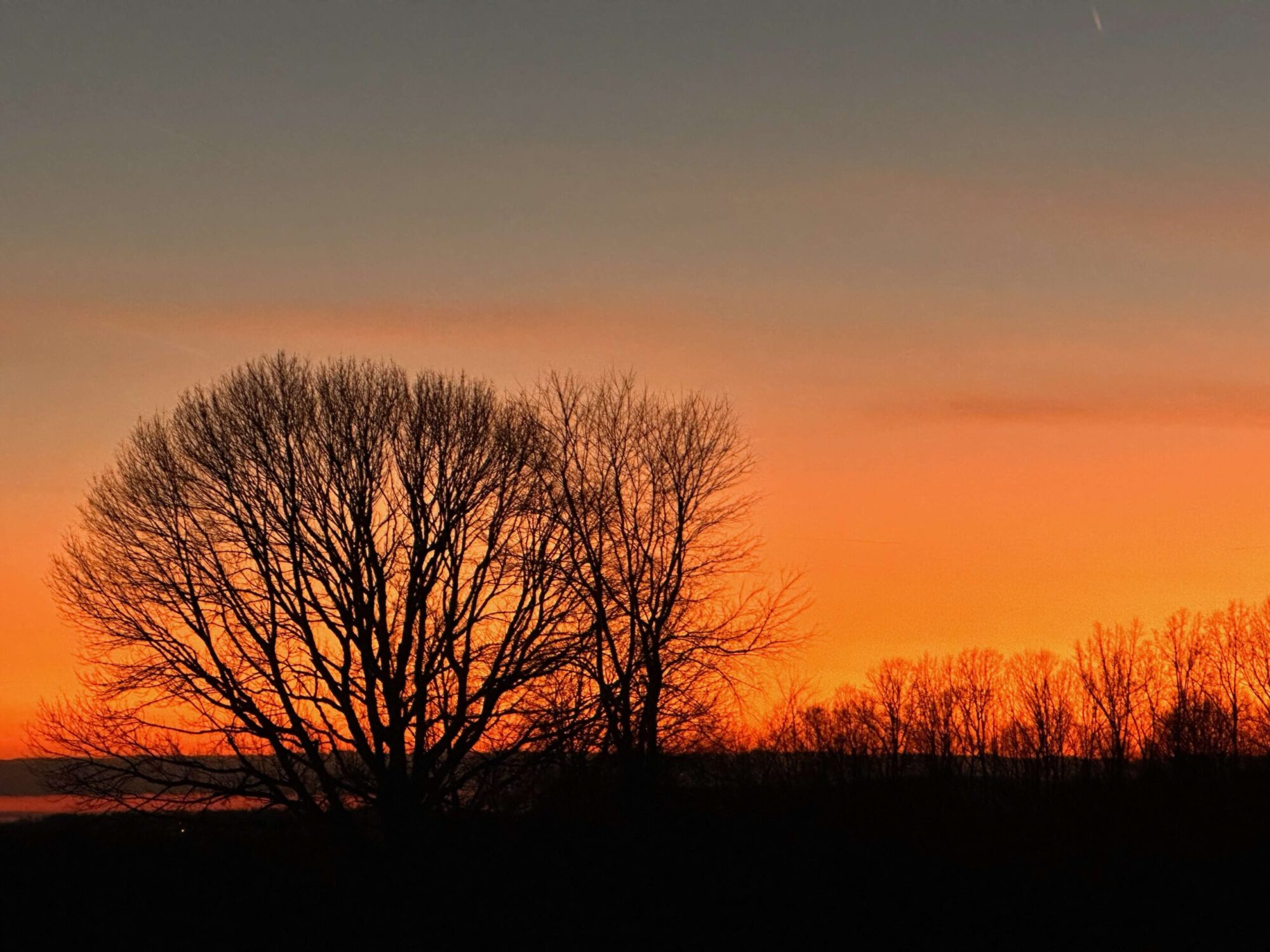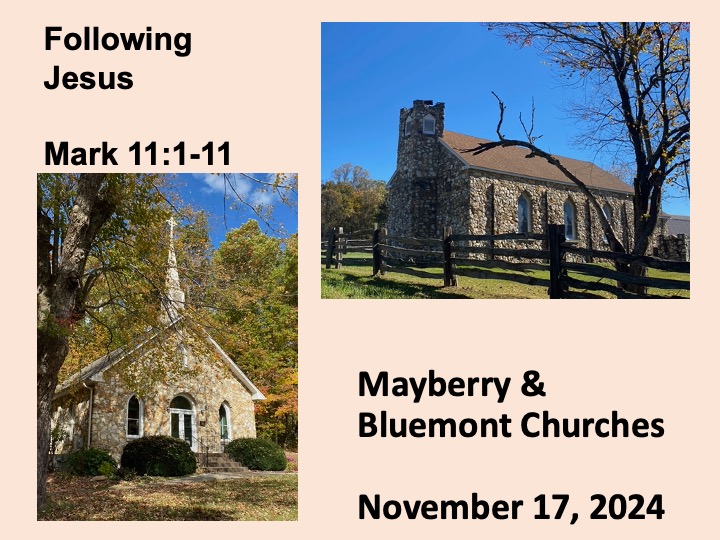Jeff Garrison
Mayberry & Bluemont Churches
November 18, 2024
Mark 11:1-11
At the beginning of worship:
“I wish it need not have happened in my time,” said Frodo in Tolkien’s The Fellowship of the Ring.
Some of you may be feeling that way today. Listen to the wise words of Gandalf. “So do I, and so do all who live to see such times. But that is not for them to decide. All we have to decide is what to do with the time given us.”[1]
It’s been years, decades, almost a half century, since I read Tolkien. But this passage, which was shared widely by many on social media over the past few weeks, rings true. We don’t get to choose the time in which we live. But what’s important is how we live during the time we’re given. Do we follow Jesus? Do we live the virtues and values he espoused: loving others, protecting the vulnerable, caring for those in need, and speaking the truth?
Or do we give in to the fleeting values and flashy ideas of the present age? There are always challenges to the gospel, but our calling as followers of Jesus is to the heavenly kingdom.
Before the reading of scripture
One of the interesting things about working through a book of scripture, chapter by chapter, is that you have little control over what comes up when. We will see this today. This will be the first time I have preached on a passage normally reserved for Palm Sunday at another time during the year. I did the same thing a few months ago. Then, I preached on the transfiguration in summer and not as the lectionary would have it, the Sunday before Lent.[2]But that’s okay. We may be better able to understand the passage without the trappings of a Palm Sunday service.
In a way, Mark’s story of Jesus’ entry into Jerusalem is anticlimactic. About half of the story focuses on acquiring the beast, which in Mark is an unbroken colt.[3] Then there is the focus on getting ready for the parade from preparing the beast and dropping cloaks and branches along the roadway. Then they entered the city singing from the 118th Psalm. For Mark, this is the first time we hear of Jesus being in Jerusalem.[4] Then Jesus and the disciples then quickly leave the city and head over to Bethany for the night. Perhaps, like today, rooms were cheaper in the suburbs than in the city center.
While we are not given the exact time, the entry into Jerusalem could have occurred on the same day as Jesus healing Blind Bartimaeus in Jericho. It seems to be late in the day when they enter the city, for they quickly leave as evening approaches. If this is the case, they’d had time to make the 15 mile walk earlier in the day.
But another option suggested by some (and supported by the Gospel of John),[5] has Jesus in the city longer than just the week recorded in the Passion. This would allow him time to meet and get to know the owner of the animal he rode the day we’re reviewing. Furthermore, the cries of Hosanna and the recitation of Psalm 118 was more in line with the fall harvest festival than the Passover.[6] But that’s a tidbit that we can’t settle, so I’ll stick to Mark’s week timeline.
Let’s listen to Mark’s report of this eventful day.
Something seems to be missing from this passage. We have Jesus, the disciples, a parade, and a crowd. But where are the authorities? Where are those in charge of crowd control? Where’s the chief priest wanting to know what’s up with this new fangle religious group?[7] Where are the Roman soldiers standing by to ensure things stay orderly? The other gospels, who tell this story, go into more detail. But Mark is sparse on details.
We always image the day to be picture-perfect. The sun shines. Wind blows just enough to keep the bugs away and to cool those marching up to the city. People pour into the Holy City for the upcoming holiday.
Jesus and his gang also come up to Jerusalem. When a few miles from town, Jesus sends his disciples into the next village to procure a colt. It sounds like Jesus had worked all this out in advance. He gives the unnamed disciples an address to find this unridden colt. And he lets them know that if challenged, they should just say, “Master needs the colt and will return it afterwards.”
The two disciples head off, find the beast, and as they are leading it back to Jesus, sure enough someone challenges them. It doesn’t sound like it’s the owner, but maybe a neighbor. And once they say, “The Master needs it,” they’re allowed to lead the animal back to the disciples’ camp.
This whole procurement of the beast may have several meanings. Does Jesus know even trivial things about the future. Not only does he know about his upcoming death, but where to find a beast and what to say when challenged for taking it. In addition, the borrowing of a horse is a pejorative of a king… And having an unridden horse could be another subtle hint of Jesus’ royalty. King’s horses were generally off-limits for everyone else.[8]
When the two disciples get back to Jesus, they place some cloaks onto the beast to serve as a saddle. Others placed their cloaks on the ground in front of Jesus, kind of like Walter Raleigh did for the Queen to earn the title Sir. Other’s place leafy branches on the ground in front of Jesus’ path. If you want to read about palms, check out John’s gospel.[9]
Jesus must have been one brave hombre, riding an animal that hasn’t been broken. But the beast seems tame. At least we’re not told of it rearing up like a bucking bronco in a rodeo. As he makes his way toward the gates of Jerusalem, the people sing the 118thPsalm, a revolutionary Psalm for it hails a new king coming on the scene.
But then Jesus goes into the gates of the city, looks around for a bit and visits the temple before heading off to Bethany. Supposedly, the two disciples returned the colt to where they found it.
Since the 8th Chapter, everything has played out with Jerusalem in the background.[10] Now they have arrived at the holy city. Jesus comes in, not as a warrior, but still honored. But the disciples, like us, have heard that Jesus isn’t going to sit on David’s throne. Instead, he’s come to the city to suffer and die. Knowing this, do we stick around with Jesus? Or would we be like the disciples and scatter when things go south while the rest of the crowd cry out for Jesus’ crucifixion?
Real transformation takes place at the cross, not in the hype of a parade.[11] Perhaps this is why Mark plays down Jesus’ entrance to Jerusalem, as compared to the other three gospels. For a religion which only stresses “feeling good” is a Palm Sunday religion and does not take seriously our human condition toward sin. Our faith must be grounded in Jesus’ death and resurrection.
Jesus’ entry into Jerusalem is about politics. In a way, Jesus mocks other politicians who entered the city with pomp and circumstance. As Jesus enters the city, at least two other significant political figures are either already in the city or will arrive shortly after Jesus. Pilate and Herod were both in the city during the Passover. While we don’t know, we could easily imagine there would have been a parade for the two of them. Such a parade would have involved fancy horses, chariots, soldiers with shinny brass, and perhaps a band.
Pilate and Herod’s arrival displayed the powers of the kingdom. Jesus’ entry displays the power of a mysterious kingdom, one not of this world
Would we have been lured by Jesus riding bareback on a colt or by the fancy horses decked out for Rome?
As we have worked through the gospel of Mark, seeing how Jesus’ entry into Jerusalem comes to nothing, perhaps we should recall the seeds which fell on rocky soil. The soil received the seed with joy, but it lasted just a short period of time before the challenges arose and without root, the plants wilted.[12]
Mark warns us. Our loyalty belongs to Jesus, not to anyone or anything else. He is the only one who can forgive our sin and heal our souls. But we must accept him on his terms, not to attempt to make him into the Messiah we want. We follow him, not the other way around. And remember, his entry into Jerusalem is but the calm before the storm. Amen.
[1] J. R. R. Tolkien, The Fellowship of the Rings. This quote has been reposted many times on Facebook and Twitter over the past few weeks.
[2] See https://fromarockyhillside.com/2024/09/01/the-transfiguration/
[3] Matthew 21:2 speaks of a donkey and a colt. Luke 19:30, like Mark, speaks of an unridden colt. John 12:14 and 14 speaks of a donkey and a donkey colt.
[4] In Luke, we’re told of Jesus being at the temple on the 8th day after his birth and again when he was 12. Matthew, like Mark, only puts Jesus in Jerusalem at the end of his life. John has Jesus in Jerusalem many times before his “Triumphant Entry.” See John 2:13, 23, 4:45, and 5:1.
[5] John 10:22, puts Jesus in Jerusalem for the Feast of Dedication (Fall festival) and then across the Jordan but still in Judea (John 10:40 and 11:54), before his entry into the city. James R. Edwards, The Gospel According to Mark (Grand Rapids, Eerdmans, 2002), 333.
[6] Edwards, 332.
[7] Matthew 21:10 speaks of the city being in turmoil after Jesus’ entry. Luke 19:39-40 tells us the Pharisees asked Jesus to have his followers to quiet things down. John’s gospel (12:19) records Pharisees throwing up their hands in resignation with all who are following Jesus.
[8] Morna D. Hooker, The Gospel According to Mark: Black’s New Testament Commentaries (1991, Hendrickson’s Publishing, 1997), 258, and Edwards, 336.
[9] John 12:12.
[10] The first of three predictions of Jesus going to Jerusalem to die was in Mark 8:31-33.
[11] This quote comes from me, which I used in a sermon on this same passage. I preached the sermon at First Presbyterian Church of Hastings, Michigan on April 13, 2014.
[12] Edwards, 338. See also Mark 4:6, 16-17. See also https://fromarockyhillside.com/2024/04/28/the-parable-of-the-sower/


Some things to think about. Have a good week.
Thanks, Mary.
I enjoyed this. “Jesus and his gang”–that is perfect.
Glad you liked that. I try to make things relatable.
You began with one of my most favorite quotes from JRRT’s LOTR, Jeff. I didn’t realize that it was being shared widely on social media right now (I’m buried, as usual), but I can understand why. Perhaps the colt sensed Jesus’s spirit. Animals can be intuitive. Do we stick with Jesus or scatter? Like Kelly, I’m glad I live now, but I do wonder how I would have reacted then. I guess each of us has to move forward with Jesus in the time we live, as he is and not as we might wish. Have a good week!
Yep, we have to make the best of our time, whether back then or now or in the future.
So often I’ve been glad that I “met” Jesus after the cross. Who knows how any of us would have responded if we’d lived in those times!?
I can’t imagine as I look at how many people today “follow Jesus” in ways I question.